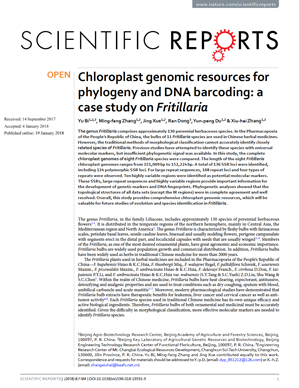NEWS 2018
Chloroplast genomic resources for phylogeny and DNA barcoding: a case study on Fritillaria
Yu BI1,2,3, Ming-fang ZHANG1,2, Jing XUE1,2, Ran DONG3, Yun-peng DUL2, Xiu-hai ZHANG1,2
Scientific Reports 8:1184 (2018)
http://dx.doi.org/10.1038/s41598-018-19591-9
1Beijing Agro-Biotechnology Research Center, Beijing Academy of Agriculture and Forestry Sciences, Beijing, 100097, P. R. China
2Beijing Key Laboratory of Agricultural Genetic Resources and Biotechnology, Beijing Engineering Technology Research Center of Functional Floriculture, Beijing, 100097, P. R. China
3Engineering Research Center of Mt. Changbai Ecological Resources Development, Changhcun Sci-Tech University, Changchun, 130600, Jilin Province, P. R. China
Abstract
The genus Fritillaria comprises approximately 130 perennial herbaceous species. In the Pharmacopoeia of the People’s Republic of China, the bulbs of 11 Fritillaria species are used in Chinese herbal medicines. However, the traditional methods of morphological classification cannot accurately identify closely related species of Fritillaria. Previous studies have attempted to identify these species with universal molecular markers, but insufficient phylogenetic signal was available. In this study, the complete chloroplast genomes of eight Fritillaria species were compared. The length of the eight Fritillaria chloroplast genomes ranges from 151,009 bp to 152,224 bp. A total of 136 SSR loci were identified, including 124 polymorphic SSR loci. For large repeat sequences, 108 repeat loci and four types of repeats were observed. Ten highly variable regions were identified as potential molecular markers. These SSRs, large repeat sequences and highly variable regions provide important information for the development of genetic markers and DNA fingerprints. Phylogenetic analyses showed that the topological structures of all data sets (except the IR regions) were in complete agreement and well resolved. Overall, this study provides comprehensive chloroplast genomic resources, which will be valuable for future studies of evolution and species identification in Fritillaria.




